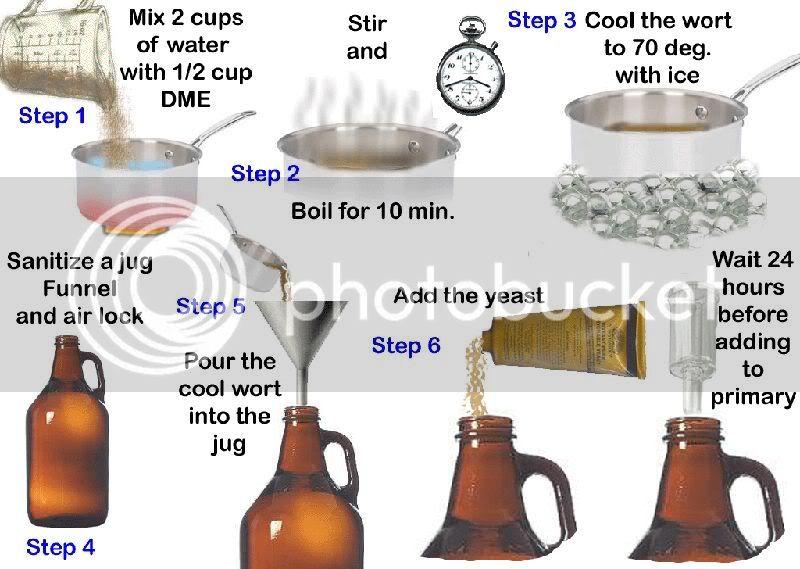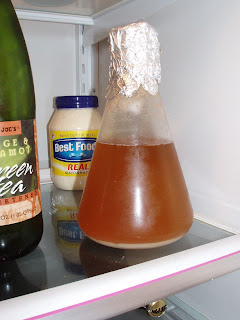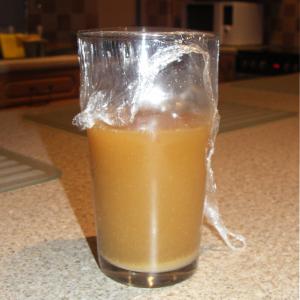Saw some discounted expired (march 2010) liquid german bock yeast wlp833. Could this ruin my batch? Should I give it a go and add more yeast if this fails to actiivate? What's the worst that can happen with expired yeast?
You are using an out of date browser. It may not display this or other websites correctly.
You should upgrade or use an alternative browser.
You should upgrade or use an alternative browser.
expired yeast?
- Thread starter drathbone
- Start date

Help Support Homebrew Talk - Beer, Wine, Mead, & Cider Brewing Discussion Forum:
This site may earn a commission from merchant affiliate
links, including eBay, Amazon, and others.
brrman
Well-Known Member
I just revived a WY1007 that was over a year old (washed yeast in a mason jar in the fridge). Had it on the stirplate for about 5 days before it was done, but it came back no problem.
I'm not familar with the revival or starter process. Would you mind going into more detail on how this works?
make a starter... which is you make about a half gallon beer with an OG of around 1.030.. I mash 2 row but using liquid or dry malt is easier. cool the wort and put it in a gallon jug, or anything clean and sanitized you can cover. pour the yeast in cover the top with sanitized aluminum foil and shake the crap out of it.....every time you think about it, pick it up and swirl it around to get the yeast into suspension...(or make a stir plate).. after a day or so you should see kraussen forming... you can either pitch the entire thing into your beer, or put it in the fridge and once the yeast all settles out, pour off the liquid and just pitch the yeast.
If you're stepping up a starter, then the age of a yeast isn't really an issue.
Bobby M did a test on year old stored yeast here; https://www.homebrewtalk.com/f13/testing-limits-yeast-viability-126707/
And my LHBS cells outdated tubes and packs of yeast dirt cheap 2-3 dollars each and I usually grab a couple tubes of belgian or other interesting yeast when I am there and shove it in my fridge. and I have never had a problem with one of those tubes.
I usually make a starter but I once pitched a year old tube of Belgian High Gravity yeast directly into a 2.5 gallon batch of a Belgian Dark Strong, and after about 4 days it took off beautifully.
With any stored, old yeast you just need first to apply the "sniff test" if it smell bad, especially if it smells like week old gorilla poop in a diaper left on the side of the road in the heat of summer.
Then make a starter, and if it takes off you are fine. The purpose of a starter is to reproduce any viable cells in a batch of yeast....that;s how we can grow a starter form the dregs in a bottle of beer incrementally...and that beer may be months old.
Even if you have a few still living cells, you can grow them....That's how we can harvest a huge starter (incrementally) from the dregs in a bottle of some commercial beers. You take those few living cells and grow them into more.
If yeast can be grown from a tiny amount that has been encased in amber for 45 million years, 45 million year old yeast ferments amber ale we really don't need to sweat too much about how old a yeast is, if it's properly stored.
we just need to think in terms of making starters. Viability isn't really an issue if you are reproducing a lot of healthy cells. Which is what you are doing when you make a starter.....
Really even with "old yeast" if there is a few cells, they will reproduce.
Bobby M did a test on year old stored yeast here; https://www.homebrewtalk.com/f13/testing-limits-yeast-viability-126707/
And my LHBS cells outdated tubes and packs of yeast dirt cheap 2-3 dollars each and I usually grab a couple tubes of belgian or other interesting yeast when I am there and shove it in my fridge. and I have never had a problem with one of those tubes.
I usually make a starter but I once pitched a year old tube of Belgian High Gravity yeast directly into a 2.5 gallon batch of a Belgian Dark Strong, and after about 4 days it took off beautifully.
With any stored, old yeast you just need first to apply the "sniff test" if it smell bad, especially if it smells like week old gorilla poop in a diaper left on the side of the road in the heat of summer.
Then make a starter, and if it takes off you are fine. The purpose of a starter is to reproduce any viable cells in a batch of yeast....that;s how we can grow a starter form the dregs in a bottle of beer incrementally...and that beer may be months old.
Even if you have a few still living cells, you can grow them....That's how we can harvest a huge starter (incrementally) from the dregs in a bottle of some commercial beers. You take those few living cells and grow them into more.
If yeast can be grown from a tiny amount that has been encased in amber for 45 million years, 45 million year old yeast ferments amber ale we really don't need to sweat too much about how old a yeast is, if it's properly stored.
we just need to think in terms of making starters. Viability isn't really an issue if you are reproducing a lot of healthy cells. Which is what you are doing when you make a starter.....
Really even with "old yeast" if there is a few cells, they will reproduce.
I'm not familar with the revival or starter process. Would you mind going into more detail on how this works?
Here's the best info on how to make a starter I have seen.

More info here https://www.homebrewtalk.com/f39/how-make-yeast-starter-pictorial-76101/
And Here's some basic info on starters and what to look for.
If it looks anything like that, your are ready to either feed it again, or use it.
Revvy said:It doesn't matter one blip in your fermenter or your starter flask if the airlock bubbles or not (if you are using an airlock and not tinfoil if you are using tinfoil, you aren't getting bibbling anyway,) or if you see a krauzen. In fact starter fermentation are some of the fastest or slowest but most importantly, the most boring fermentations out there. Usually it's done withing a few hours of yeast pitch...usually overnight when we are sleeping, and the starter looks like nothing ever happened...except for the little band at the bottom. Or it can take awhile...but either way there's often no "activity" whatsoever....
I usually run my stirplate for the first 24 hours, then shut it down, if you are spinning your starter it is really hard to get a krausen to form anyway, since it's all spinning, and there's often a head of foam on it from the movement.
All that really matters is that creamy band o yeast at the bottom.

This is a chilled sample so it's flocculated, but even with an unchilled sample you should see a band of yeast at the bottom. Here's an unchilled version

Same thing, a band.
As it is I've only ever seen two or three krausens actually on my starter (one blew off a bunch of krausen and knocked the tinfoil off the flask,) and the evidence of one on the flask at the "waterline" once. But I've never not had a starter take off.
Look for the yeast at the bottom, don't worry what it looks like on top.
If you have yeast on the bottom....that's all you really need.
If it looks anything like that, your are ready to either feed it again, or use it.
brrman
Well-Known Member
I just revived a WY1007 that was over a year old (washed yeast in a mason jar in the fridge). Had it on the stirplate for about 5 days before it was done, but it came back no problem.
I'm not familar with the revival or starter process. Would you mind going into more detail on how this works?
Apologies - didn't notice this was in the beginner section or I would have explained. But since I always go to threads from the "New Posts" link I forget to note where the thread lies.
OHIOSTEVE and Revvy have given great advice.
I'd suggest just picking up a new pouch, 8 years is a long time for yeast to sit around.
porter1974
Well-Known Member
- Joined
- Nov 4, 2017
- Messages
- 104
- Reaction score
- 41
The original post is from 2010. Imagine how old the yeast is now!
Similar threads
- Replies
- 1
- Views
- 442
- Replies
- 5
- Views
- 887
- Replies
- 8
- Views
- 987
